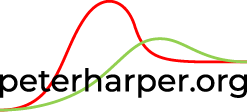Food
The Great Climate Debate has generally - and rightly - focused on energy. However it has gradually become clearer that food and land-use too, are significant contributors to the problem, and also exert strong pressures on other 'planetary boundaries' such as biodiversity, water availability and nitrogen overload. Soils too, why aren't they on the list?
It has also become clearer that the decarbonisation of energy systems consists principally of technical measures that from social and political perspectives are fairly straightforward. We know how to do it, and (with due acknowledgement to the many thorny practical issues) it's just a question of Getting On With It.
Not so with food! This is much more difficult to decarbonise without considerable changes in diet and agriculture that cut across deeply embedded cultural preferences. As emissions from energy decline, those from food and land use will become a larger and larger proportion until they dominate the picture.
Energy decarbonisation scenarios are now two a penny, but there are very few special studies of the land use systems, and almost none that integrate energy, food and land, with the key exception of CAT's Zero-Carbon Britain series.
For these reasons I have moved much of my analytical effort from energy to food and land use. Land-use problems are largely driven by food policy, so I have decided to give Food its own section in this part of the web site, leaving Land Use and Agriculture a separate section of its own. But of course they overlap a lot.
Even a superficial analysis will quickly reveal that livestock and livestock products contribute a disproportionate share of most recognised impacts, climate-related and otherwise. This is the root of the largest cultural collision between preference and sustainability, and clearly is a Very Big Problem. However, once this nettle is grasped, and diets are re-envisioned with much lower livestock components, nearly all the other problems become much more tractable. Furthermore, a wide range of hidden resources and benefits emerges.
The bare bones of this analysis was already understood by the early years of the century, and I wrote a short article on it in 2006, "Food and Carbon Emissions".
This perspective fed into the treatment of food and land-use in the series of Zero-Carbon Britain reports produced at the Centre for Alternative Technology in 2007, 2010 and 2013. A summary of recent conclusions is found here.
Much of this material has found its way into public lectures and exists in the form of Powerpoint presentations, for example Low Carbon Food and Diets (2013). I have also conducted substantial courses on the same topics, see for example Lecture Notes on Post-Carbon Food (2014). I also organise food-related stunts such as The Trial of Daisy the Cow. Daisy’s latest outing was at the University of Bath, following this draft script.
In the small Wiltshire town where I live, there is considerable interest in local food provision, and I am simultaneously enthusiastic and sceptical. My beady-eyed analysis here.
I am also interested in experimental foods. Recently I have been collecting, processing and cooking acorns, see here. The image below shows a bowl of ‘acorn hoummous’. Very tasty, and needs no tahini.
Acorns can be very beautiful. Here is a bowl of fresh ones collected in 2019.
It striking that in the area where I live acorn production is very erratic. Acorns are abundant on some lower branches of about one tree in ten or twenty, but absent elsewhere or affected by gall wasps, producing slightly sticky acorns with irregular lobes.
A NEW FOOD COURSE IN THE GRADUATE SCHOOL OF THE ENVIRONMENT AT CAT
In 2017 the GSE initiated a new MSc course entlitled Sustainable Food and Natural Resources. I was involved in both planning and teaching this course. https://gse.cat.org.uk/index.php/postgraduate-courses/msc-sustainable-food-and-natural-resources/sfnr-overview
Buildings of the Wales Institute for Sustainable Education, CAT, Mid-Wales
You can pretend to be there by looking over my shoulder and perusing some of the material I presented. For example
Distance-Learning students get the following Materials:
Spreadsheet Exercises on Food and Agriculture Doc 2018
Modelling the UK Diet Excel Spreadsheet 2017
Modelling the present UK agricultural system Excel Spreadsheet 2017
Modelling alternative scenarios for UK agriculture Excel Spreadsheet 2015
Classroom students get 'pairs' of lecture notes and presentations:
Food Security Doc 2015
Food and Food Security Powerpoint Presentation 2018
All students get discussion papers about matters that have arisen in the class. For example
Are British peas a low-carbon food? Further Adventures of the Peas Doc 2018
What is the Association Between Diet and Social Class? Class and Diets Doc 2018
Could You Survive on Wild Foods? Foraging Exercise Doc 2018
A supplement to the foraging exercise is found in my experiments with acorns, see Preparing Edible Foods from Acorns Doc 2018
Wild foods collected ast CAT and prepared in various ways. Left, tempura; centre, steaming; right, salad with oil and salt dressing.






